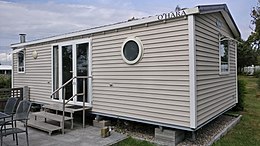Mobile home
A mobile home , Engl. Mobile home , is a transportable residential unit, the interior of which is comparable to an apartment. Mobile homes are a form of mobile architecture . In contrast to caravans , mobile homes are not street legal and can only be transported over longer distances by truck . To move around a campsite or in a trailer park , a mobile home has a simple axle without a brake.
The limited mobility is sufficient to have a holiday home with the erection of mobile homes on permanent camping sites , which is permitted in Germany , without having to comply with the usual building regulations . Mobile homes are available on many campsites; they are often rented out.
The structure
The construction of a mobile home basically follows a certain scheme. This can vary slightly depending on the model and manufacturer. The materials and insulation materials also differ and can be adapted to the wishes of the customer.
Floor and chassis
In a mobile home, the base of the floor often consists of a layer of joists and a support frame. This can either be made of wood or steel. Floor panels made of plywood can be laid on the supporting structure . Depending on the model and price range, there is an insulation layer between the supporting structure and the floor panels, which can be of different thicknesses.
The top layer of the floor is the floor covering. The same materials can be laid here as in permanent houses. In order for the mobile home to be transported, it needs a chassis and a drawbar . Both are basically made of steel to withstand the heavy load.
walls
Interior walls
The interior walls of a mobile home are usually made of plaster of paris or MDF panels. Due to the small size of a mobile home, it makes sense to equip the walls with soundproofing .
Exterior walls
The outer walls of mobile homes can be made of different materials. Wood is recommended as the base material for winter-proof mobile homes. In addition to good insulation, vapor barriers should also be integrated in the outer walls to ensure a long retention period . Cheap models often have aluminum cladding and are poorly insulated.
top, roof
Basically, all roof shapes are possible for mobile homes. Manufacturers and customers mostly use flat and gable roofs to keep costs down. The roof consists of a roof beam construction, insulation, vapor barrier and rear ventilation levels, wood-based panels and the interior and exterior cladding. From the inside, the construction is usually covered with plasterboard or MDF panels. On the outside, the wood-based panels are often clad with bitumen shingles. Green roofs are also possible.
Windows and doors
Windows and doors can be installed in mobile homes according to taste. All sizes and shapes are possible. For sufficient insulation, the windows should be at least double-glazed and the outside doors should be well insulated.
Outdoor area
Mobile homes are often raised slightly and have verandas . Mobile homes close to the ground can be expanded with terraces .
Interior
The interior is comparable to that of a small apartment. There is a kitchen, bathroom and the usual electrical installations in living rooms . Mobile homes have a connection for electricity and fresh and waste water connections and a bathroom, toilet with water flushing and shower or bath. The kitchens are mostly fitted kitchens with a hob, stainless steel sink, refrigerator, etc.
Mobile homes offer enough space to set up furniture (e.g. couch, wardrobe, bed). In contrast, a caravan has only built-in furniture; the mostly U-shaped seating area can almost always be converted into a bed.
Mobile homes in the USA
In the United States , a mobile home also includes portable housing units that do not have an axis. They are manufactured in a production facility or at least prefabricated there and then transported to their destination. Basically, these buildings can still be moved later, depending on the type of construction, this is more or less complex. As a rule, this type of construction is cheaper than on-site construction. There are also mobile homes in the USA that look like the mobile homes known in Europe. They are in simple trailer parks (trailer parks) and also in more comfortable facilities with a swimming pool.
In the mid-1970s, eight million people lived in 3.4 million mobile homes in the United States. This was preceded by a change in the practice of granting mortgage loan guarantees. The Housing Act of 1969 allowed the Federal Housing Administration to insure mobile homes up to a value of $ 10,000 for a term of up to twelve years for the first time.
supporting documents
- ↑ Donald Sullivan: Housing in the 1970's, in: Gertrude Sipperly Fish (Ed.), The Story of Housing, New York, 1979, pp. 382-398, here p. 387.
literature
- Margaret J. Drury: Mobile Homes, New York 1972
- Donald Sullivan: Housing in the 1970's, in: Gertrude Sipperly Fish (Ed.), The Story of Housing , New York, 1979, pp. 382-398.

